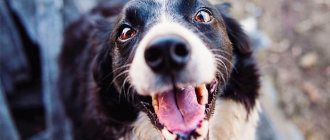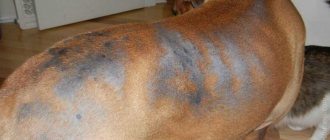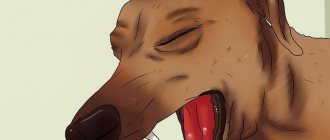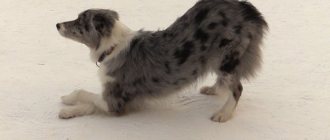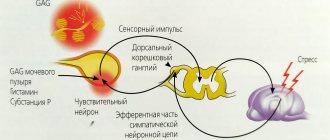Types of pneumonia in dogs
Depending on the cause of its appearance, pneumonia in dogs can be infectious or aspirational. Another 2 types are determined by the degree of organ damage. These include catarrhal and croupous forms.
Infectious, including fungal
An infectious species is diagnosed when pathogenic microflora is detected. Depending on the type of pathogen that has entered the body, pneumonia in dogs occurs:
- viral
, developing after viruses enter the lung tissue through the bloodstream;
- parasitic
caused by helminths;
- bacterial
, which occurs when infected with bacteria and as a complication of bronchotracheitis - inflammation of the mucous membranes in the trachea and bronchi;
- fungal
, which develops when infected with yeast-like fungi;
- protozoan
, caused by the protozoan parasite Toxoplasma.
Symptoms and treatment of bacterial pneumonia in dogs are distinguished by the brightness of the clinical picture and difficult rehabilitation. This species is considered the most dangerous. Most often it is diagnosed in male dogs.
Aspiration
In the aspiration form, the inflammatory process is non-infectious. It occurs with chest trauma or neuromuscular diseases of the esophagus and pharynx.
Catarrhal
An alternative name for this form is bronchopneumonia. The inflammatory process affects not only the alveoli, but also the bronchi. There is a discharge of serous fluid. The nature of the pathology is focal. The lesion is observed on a small part of the lung tissue. Due to its mild signs and symptoms, catarrhal pneumonia in dogs is often treated at home.
Krupoznaya
In the croupous form, inflammation covers the entire organ or most of it. The most severe course is characterized by pathological changes on both sides. Fibrin, leukocytes and erythrocytes are washed into the lumens of the lung tissue. As a result, extensive swelling of the bronchi develops, interfering with breathing. A sick animal requires urgent hospitalization and artificial ventilation.
Symptoms
Pneumonia in a dog is characterized by several signs that will help the owner to suspect the disease in time and seek help. When the first symptoms of the disease appear, you should not delay visiting a doctor, as the infection can progress very quickly, leading to fatal consequences.
The main symptoms of pneumonia include:
- Cough. This is a leading sign of respiratory dysfunction. It can indicate both pneumonia and other diseases (bronchotracheitis, tonsillitis, chronic sinusitis) or the penetration of a foreign body into the bronchi. The presence of a cough requires mandatory examination at a veterinary clinic.
- Fever. She speaks of the active phase of the inflammatory process.
- Intoxication – lethargy, weakness, loss of appetite.
- Heavy breathing, shortness of breath.
- Vomit.
- Weight loss.
- Rapid pulse.
As the disease develops, it is important to monitor changes in the animal’s condition over time. You should describe in detail to the veterinarian how the animal’s behavior changes. This is necessary so that the doctor can fully assess the situation and choose the most optimal treatment tactics.
Causes of lung problems
The risk group includes older dogs, puppies, animals with chronic diseases and congenital pathologies of the respiratory system (rhinitis, tracheitis, sinusitis). What they all have in common is weak immunity, vulnerable to infectious factors.
In addition to health status, living conditions are important. Most often, problems with the lower respiratory tract occur in guard, hunting and sledding breeds living on the street. All these animals are subject to sudden changes in temperature and hypothermia.
Also, indirect factors that provoke the inflammatory process include:
- advanced primary infections that caused a problem with the lower respiratory tract as a complication;
- poor nutrition, containing a small amount of minerals and vitamins;
- lack of hygiene (crowded housing, use of dirty feeders);
- neglect of vaccination and treatment against parasites;
- stress and allergies;
- chemotherapy, postoperative period or long-term use of certain drugs.
All these factors undermine the pet’s health, but do not always lead to pulmonary diseases. A more obvious pattern can be seen among the main causes. They can be divided into 3 groups
:
- Infection
viruses, bacteria, fungi, protozoa and helminths. Infection in the alveoli and lung tissue is the most common cause.
- Chest injuries
. The danger comes from open wounds, lung bruises and any heart injuries.
- Entry of foreign objects and liquids
. Lung tissue is damaged by involuntary ingestion of vomit, medications, insects or small debris. This disorder is called aspiration. In this case, swallowed bodies and liquids do not enter the stomach, but directly into the lungs.
In rare cases, the employees of the veterinary clinic are to blame for the illness. A newborn puppy may develop inflammation due to incorrect insertion of the tube during artificial feeding.
Causes of aspiration pneumonia
The main reason is the penetration of oropharyngeal or gastric contents into the lungs. In other words, foreign masses enter the respiratory tract from the gastrointestinal tract (vomiting) or when they are swallowed. They can be liquid (saliva, water) or thick, dense (from the gastrointestinal tract). Often - solid bodies, when a dog accidentally inhales something that it picked up from the floor during play (a ball, a button, a piece of a toy, etc.).
It is important to understand what became the subject of aspiration. This has diagnostic value, since the masses from the stomach are sterile (acidic), and those from the oropharynx (alkaline) are often contaminated with bacterial microflora.
In case of chemical pneumonitis, sterile inflammation of the respiratory tract is diagnosed; an acidic environment is present and it very quickly provokes the inflammatory process. When a foreign body enters the mouth, the veterinarian detects the presence of bacteria in the lungs in almost 100% of cases.
Mixed aspiration also happens; it is especially difficult and requires long-term hospital treatment, especially in advanced cases.
Common causes of aspiration:
- pharyngitis (and impaired swallowing);
- megaesophagus;
- vomiting, especially during general anesthesia or in a fainting animal;
- CNS diseases;
- poor-quality therapeutic manipulations (improper use of a gastric or nasoesophageal tube).
Very often, pets come to see a veterinarian at the Ros Vet Center after inept manipulations with medicinal substances by their owners. Giving drugs, especially in liquid form, is a rather complex manipulation that requires specific virtuosity and skills. If medications or irritants enter the lungs when a dog or cat involuntarily sighs, aspiration pneumonia develops. Brachycephalic pets (bulldogs, Persians, exotics, pugs, etc.), which have a congenital narrowing of the upper respiratory tract, are predisposed to the pathology. Dogs suffer from pulmonary aspiration more often than cats.
Symptoms at different stages
Based on the severity of the symptoms, pneumonia in dogs can be of two types: acute and chronic. The first form is characteristic of the introduction of viruses or aspiration, the second - of infection by parasites. The chronic form is characterized by a sluggish course in the early stages. It is more difficult to diagnose, so the four-legged patient who finally gets to the veterinary clinic often ends up in serious condition.
Regardless of the severity of the symptoms, the pathology goes through 3 stages
:
1. Primary
. Direct damage and onset of the inflammatory process in the lung tissue. The duration of this stage is no more than 5 days. External changes are not observed or are weakly expressed.
Due to the increased permeability of blood vessels, the pulmonary capillaries become overfilled with blood. As a result, exudate leaks into the pulmonary alveoli. In composition it is:
- serous
, that is, almost transparent;
- fibrinous
, that is, containing fibrin (its lack is fraught with hemorrhages);
- purulent
, that is, greenish, cloudy and viscous.
2. Secondary
. Lung tissue becomes denser, preventing the flow of oxygen. Together with the exudate, leukocytes and erythrocytes exude from the affected tissues. The stage lasts no more than 10 days and is characterized by a vivid clinical picture and maximum intoxication of the body. The severity of the current can be easily tracked by temperature. The higher it is, the greater the likelihood of complications. With severe intoxication, breathing is impaired and loss of consciousness is possible.
3. Final
. The prognosis depends on the time of detection of the disease and the patient’s immunity. With timely treatment, the affected tissues are completely restored. In more severe cases, the likelihood of death is high.
Due to the blurred clinical picture at the primary stage or in the chronic form, inflammation can easily be confused with a common cold. It is possible to prevent unpleasant consequences if you know the specific signs of pneumonia in dogs.
Therapy and prognosis
In case of aspiration pneumonia, the animal must be treated in a hospital; home treatment is not provided. The main step is to clear the airways of foreign matter and prevent the development of infection. They use drugs that relieve bronchospasm, glucocorticoids, antibiotics, bronchodilators, mucolytics. In severe cases, probing or surgery is performed.
If you suspect that a foreign body has entered your pet’s respiratory tract, do not hesitate. It is the first hours that determine the further prognosis for aspiration pneumonia. Call the Ros Vet Center by phone and deliver the animal to the clinic in a timely manner.
How to distinguish pneumonia from a cold
Like the flu, pneumonia in dogs is accompanied by chills, nasal discharge, lethargy and loss of appetite. A sick pet has a fever. Due to temperature fluctuations, he loses strength, and due to increased sweating, he is constantly thirsty. To make a correct diagnosis, check for the following symptoms:
:
- frequent wet, loud and painful cough with green sputum or streaks of blood;
- the appearance of shortness of breath (nasal passages become clogged with dried crusts), wheezing and whistling when breathing;
- blue discoloration of the mucous membranes of the mouth and lips, which occurs due to lack of oxygen;
- yellowing of the whites of the eyes, which occurs with the croupous form;
- increased heart rate.
The nature of the lesion can be recognized by the behavior of the pet. If it lies only on one side, then the inflamed organ is on the opposite side. In the case of bilateral damage, attacks of pain occur in any position.
Diagnostic methods
If pneumonia is suspected, the veterinarian will first perform lung percussion to detect areas of dullness and auscultation to assess breath sounds. Detection of wheezing, increased respiratory sounds, and attenuation of breathing in different areas of the lungs indicate a pathological process.
A general blood test is characterized by neutrophilic leukocytosis with a shift to the left. If eosinophils increase, the parasitic nature of the disease may be suspected. Bronchial washings and sputum analysis help identify the pathogen and select an effective antimicrobial agent. The arterial gas test allows you to determine the degree of oxygen saturation of red blood cells.
An informative diagnostic method is an x-ray examination of the animal's chest. The inflamed area of the lungs appears on the image as a darkening with an uneven border.
Pneumonia in a dog
Differential diagnosis is carried out in relation to such pathologies as bronchitis, rhinitis, pharyngitis, tonsillitis, lung abscess, pleurisy.
Diagnosis and treatment
After detecting alarming symptoms, it is important to take the animal to a veterinary clinic as quickly as possible. The doctor will be able to prescribe treatment only after a thorough diagnosis.
Definition of disease in a veterinary clinic
The task of diagnosis is to separate pathology from similar diseases: bronchitis, rhinitis, acute tonsillitis, tracheobronchitis. All these diseases have similar symptoms, but require different treatment regimens.
During the examination, the four-legged patient's chest is auscultated and tapped. This is necessary to detect breathing sounds and understand the physical condition of organs.
The most informative method is radiography. Using the resulting image, the veterinarian determines the presence of the disease and the extent of organ damage. For a more detailed picture, x-rays are taken in two projections. Pathology is confirmed when darkening with unclear boundaries is detected.
Internal changes are noticeable in the results of a biochemical blood test. In the presence of a foreign substance, the production of neutrophils and eosinophils increases. These cells are part of the white blood cell group and are used by the body to kill infections. An arterial gas test is performed to check the level of oxygen in the blood. The exact type of pathogen is diagnosed by sputum analysis and bronchial swabs. This is necessary for choosing medications.
Drug therapy
First of all, therapy is aimed at stabilizing the condition and eliminating the root cause. After this, the emphasis is on restoring lung tissue, removing remaining symptoms and boosting immunity.
Treatment of pneumonia in dogs depends on the condition of the animal:
- Stable
. If the symptoms are mild and the patient is feeling close to normal, they are treated at home.
- Unstable
. Fever, severe weakness and complete refusal to eat require temporary hospitalization.
- Critical
. In case of oxygen starvation, artificial ventilation is required.
In case of severe exhaustion and dehydration, infusion therapy is carried out in the hospital. To replenish strength, the four-legged patient is given intravenous injections of physiological solutions (Ringer's acetate, glucose).
Drug therapy includes taking mucolytic (sputum thinning) and expectorant drugs. In the infectious form, the main emphasis is on antibiotics. The best effect is provided by complex action drugs aimed at combating several types of pathogens. These include Amoxiclav, Gentamicin and Ampicillin. All dosages are individual and selected by a doctor. For faster action, an injection form of antibiotics is used.
When injected, the active substance immediately enters the bloodstream and reaches the desired organ through its flow. The minimum duration of therapy is 2 weeks. If affected by chlamydia or legionella, the duration of treatment increases to 1 month.
Physiotherapy helps remove phlegm. Among the procedures used are chest massage, electrophoresis and UHF heating. This treatment involves exposure to high-frequency current, so it is prescribed only after the acute form of the pathology has been eliminated. The procedures are stopped after the cough disappears.
Complex therapy is not complete without taking vitamins. The patient is prescribed multivitamin preparations, and also given intramuscular injections of group B and C elements.
Home care
Treatment outside the hospital is possible after the condition has stabilized and appetite has returned. Prepare a comfortable place for the patient in advance. Choose a warm, dry area away from drafts.
Follow your veterinarian's advice strictly. Do not use cough suppressants. Because of this, phlegm will remain inside and cause re-inflammation. Also remember that discontinuation of antibiotics, vitamins and other medications is permissible only in consultation with your doctor. If the symptoms have disappeared, and the time of administration has not yet ended, continue to give the dog the medications anyway.
During the cold season, it is recommended to temporarily stop walking. Low temperature is one of the indirect factors responsible for the occurrence of the inflammatory process. By agreement with the veterinarian, warming with an infrared lamp and massage sessions can be done at home. These procedures are aimed at removing secretions that accumulate in the bronchi.
Remember that the use of folk remedies is unacceptable. At best, they will not give any effect, at worst, they will aggravate the condition, causing an allergic reaction. An exception is permissible only after complete recovery, when the use of herbs is aimed at restoring immunity. But even in this case, it is important to follow your doctor's recommendations.
The effectiveness of therapy is determined using x-rays. The frequency of the study is agreed with the doctor.
Treatment options
The main task in case of pneumonia in a dog is to stabilize the condition as quickly as possible and stop the causative agent of the disease.
General rules of therapy
Pneumonia is a dangerous disease, the treatment of which must adhere to certain rules:
- place the dog in a warm room without drafts;
- do not give the animal cough suppressants;
- give antibiotics and other medications only as prescribed by a doctor, strictly follow the dosage;
- do not take the animal outside in cold weather;
- after the exacerbation is relieved, light physical activity is allowed;
- You should absolutely not resort to folk remedies for treating pneumonia, so as not to aggravate the animal’s condition.
Helping a dog in a hospital
It is preferable to treat inflammation in a hospital in order to be able to quickly stop dangerous symptoms and monitor the dynamics of the condition. The main method of treatment is antibiotic therapy. Typically, they are administered by injection. With this method of administration, the active substances reach the site of inflammation faster. Before using antibiotics, a sensitivity test is performed.
The selection of drugs is carried out taking into account the type of pathogen. In the presence of chlamydial and mycoplasma pneumonia, macrolides (Sumamed), tetracyclines (Doxycycline), and fluoroquinolones (Ofloxacin) are used. Inflammation caused by E. coli is best treated with cephalosporins (Ceftriaxone.
Uncomplicated types of pneumonia are treated with antibiotics for at least 10 days. Even with a satisfactory condition of the animal, you will have to fight against mycoplasmas and chlamydia for at least a month.
In the presence of vomiting, diarrhea, and difficulty breathing, infusion solutions (glucose, saline, Ringer's solution) are administered intravenously.
View a selection of effective treatments for acute kidney failure in small breed dogs.
The pros and cons, as well as the standards of the Longhaired Chihuahua dog breed are written on this page.
Go to https://melkiesobaki.com/soderzhanie/kormlenie/korm-proplan.html and see an overview of the tastes and variety of Proplan Dental food lines for dogs.
Caring for an animal at home
After relief of dangerous symptoms, treatment can be continued at home. It is very important to prevent the condition from worsening and pneumonia becoming chronic.
Home therapy includes the following activities:
- Light tapping massage of the chest 3-4 times a day to stimulate mucus production.
- Light physical activity.
- Removing mucus from the lungs using medications prescribed by the doctor.
- Avoid walking in damp, cold weather.
- Creating a diet that will promote rapid recovery.
- The use of vitamin-mineral complexes.
- Constant monitoring by a doctor.
Stages and development of pneumonia. Diagnostics
First stage
At this stage, there are practically no symptoms, or they are mild. This period lasts up to 5 days, after which it passes into the next stage.
Second stage
The stage lasts no longer than 10 days, and there are all the symptoms that are characteristic of pneumonia. It is at this time that the animal must be shown to the veterinarian. This period allows you to completely eliminate the disease without disrupting the functioning of other organs of the animal.
Final stage
If the symptoms are quickly recognized at the final stage, a cure or significant improvement in the animal’s condition occurs. If treatment is not given, death is likely to occur. In addition, the disease can be mild, moderate, severe or super severe. Treatment and symptoms depend on this. Also, the pathological process can be divided into:
- spicy;
- subacute;
- chronic.
In this case, chronic pneumonia can develop due to the ingress of foreign bodies or liquids. This is also called aspiration pneumonia.
Diagnosis of pneumonia begins with an x-ray. This allows you to see what part of the lungs is affected and the severity of the situation. It is also necessary to take a general blood test. This allows you to see the cause of the disease, the possible presence of roundworms and larvae in the animal’s body and directly in the lungs themselves. Since there are many causes of pneumonia, it is important to seek help from an experienced specialist who will take into account not only the results of a blood test and symptoms, but will also pay attention to the age of the animal and the presence of breed characteristics.
Therapy
Treatment of pneumonia in a dog is best done in an inpatient setting at a veterinary clinic. If this is not possible, then therapy is carried out at home, but under the strict supervision of a veterinarian. Treatment of pneumonia in dogs at home, as well as in a hospital, takes 14 days.
The first thing your doctor will recommend is a diet to boost your immunity; foods should be rich in proteins and carbohydrates.
Before prescribing antibiotics, the clinic's laboratory must isolate the microorganisms that lead to pneumonia from sputum from the animal's lungs. Next, an analysis is made of the reaction of microorganisms to drugs, thus identifying the drugs that are most suitable for treatment.
Broad-spectrum antibiotics are suitable for the treatment of aspiration pneumonia in dogs, as well as other bacterial and infectious diseases:
- "Ampicillin";
- "Amoxiclav";
- "Amoxicillin";
- "Solyutab";
- "Gentamicin";
- "Cefotaxime" and "Ceftriaxone";
- "Vilprafen";
- "Sumamed";
- "Gentamicin";
- "Doxyciline."
This list is incomplete; your doctor may prescribe a different drug. It is worth noting that antibiotics for pneumonia are used in two or even three types at once, since each has its own effect (on gram-positive or gram-negative cocci).
Traditional antibiotics are used to treat chlamydial and world-plasma pneumonias. The veterinarian may prescribe:
- "Ciprofloxacin";
- "Sumamed";
- "Doxycycline";
- "Ofloxacin" and so on.
If worms are detected in the dog’s body, it will be necessary to get rid of them during therapy. Only a veterinarian will prescribe medications for parasites; you should not buy the first drops you come across at a pet pharmacy.
The course of antibiotics is at least 10 days for mild cases of the disease. If pneumonia is caused by chlamydia and mycoplasmas, then even in a mild stage, antibiotics will need to be used for at least a month.
The animal will also be prescribed physical therapy and oxygen for severe pneumonia.
Not only during illness, but also at the first signs of recovery, you should not take your pet for a walk, as this can cause a relapse or complications.
Features of the course of the disease
There are several stages of development of the disease:
- The primary stage (with lobar inflammation it is called the stage of flushing or active hyperemia) lasts up to 3 days. The pathogen penetrates the lung tissue, causing inflammation. The vessels of the organ become overfilled with blood, and exudate begins to be released into the alveolar spaces.
- Secondary stage (stage of red and then gray hepatization). May last up to two weeks. The lung tissue becomes denser (taking on the consistency of the liver), as a result of which the supply of oxygen to the bloodstream is sharply disrupted. Red blood cells and then leukocytes sweat into the alveolar exudate. Clinical signs are most acute. Intoxication reaches its peak.
- The final stage. With a favorable outcome, the normal structure of the lung tissue is restored and the exudate is liquefied.
Depending on the type of pathogen, the state of the dog’s defenses and other factors, the disease can progress in different ways. There are three degrees of severity:
- Easy. No intoxication. Slight increase in temperature. The presence of a small focus of inflammation.
- Average. Moderate intoxication. The temperature may be increased slightly, but quite active formation of exudate is observed.
- Heavy. Severe intoxication. Loss of consciousness may occur. Body temperature is critically high. Active infiltration is underway. The dog is very weak and is breathing frequently. Complications may develop.
Mechanism of disease
Pneumonia is an inflammation of the lower respiratory tract, involving all structures of the lung tissue, including the alveoli (cavities of the lungs involved in the respiratory process). It can have a different (but predominantly infectious) nature, and is also a complication of many diseases of the respiratory system.
The mechanism of the disease is quite simple: the pathogen, having penetrated the respiratory tract, causes inflammation in the alveoli. In the presence of a reduced bronchopulmonary barrier, transmission of infection occurs through the alveolar septa. The product of an extensive inflammatory process in pneumonia is usually exudate, the type of which corresponds to the type of disease.
As a result, the process of supplying blood vessels with oxygen, in which the alveoli participate, is disrupted, causing hypoxia. As the disease progresses, respiratory and then heart failure develops. If the course of treatment is ineffective, the patient's condition becomes severe, the disease progresses, causing further deterioration. In this case, death is possible.
Risk group
The risk group for the disease includes dogs with chronic infectious diseases, congenital disorders of the respiratory system, as well as animals with serious immunodeficiency conditions. Pneumonia often develops in weakened and emaciated dogs. Animals on duty and living on the street (hunting, guard, riding) are also at risk. Puppies and older dogs are especially susceptible.
What is pneumonia, types of disease
Pneumonia is inflammation of the lungs. Most often it is divided by etiology (i.e. by type of origin):
- Viral.
- Bacterial.
- Fungal.
- Some experts identify a parasitic form. It develops against the background of a puppy being infected with roundworms (parasitic nematodes), the larvae of which “live” in the animal’s lungs for about two weeks, causing the development of an inflammatory process.
We also need to make one important digression. Many scientists believe that the viral and parasitic forms should always be classified as a mixed type, since neither viruses nor even parasites themselves cause inflammation. It develops as a result of the intervention of conditionally pathogenic or pathogenic secondary microflora. In addition, pneumonia can be divided according to the location of the inflammatory process:
- Focal. As a rule, in this case, inflammation covers only a small focus (sometimes a couple of dozen alveoli).
- Segmental. In this case, several segments are already covered (i.e. several alveolar packets).
- Share . A fairly serious type of pneumonia; entire lobes of the organ are involved in the inflammatory process.
- Drain. Most often it is a transitional form, when focal or segmental areas of inflammation begin to merge into a single whole.
- Total. The most severe type of disease. Either the entire lung or both lungs are affected. Often leads to death.
Etiology of the disease
Depending on the etiology, pneumonia can be infectious or non-infectious.
Infectious pneumonia
Infectious pneumonia is often bacterial or viral in nature. It can develop as a primary or secondary disease against the background of influenza, bronchitis, tracheitis or tonsillitis. Depending on this, the causative agents of infectious pneumonia are:
- gram-positive microorganisms (staphylococci, streptococci, pneumococci);
- gram-negative microorganisms (enterobacteria, Escherichia coli, Proteus);
- mycoplasmas (causative agents of mycoplasmosis);
- viruses (herpes, influenza, parainfluenza, viral distemper);
- fungal infections;
- parasites (larvae of Toxocara, hookworm, filaria).
Infection of animals occurs mainly by airborne droplets, contact or hematogenous routes:
- through contact with sick animals;
- through contaminated food, dirty dishes, feces of sick animals;
- through infected blood and lymph.
Non-infectious pneumonia
Inflammation of the lungs of a non-infectious etiology in a dog is caused by the entry into the lung cavity of foreign agents of a non-infectious nature, namely:
- Aspiration pneumonia in dogs occurs after inhalation of foreign particles, foreign bodies (dust suspension, small debris), as well as when contents of the oral cavity or stomach enter the respiratory tract.
- Post-traumatic pneumonia is the body’s reaction to a violation of the integrity of the chest.
- Postoperative pneumonia is caused by complications after surgical interventions.
- Exposure to toxic substances on the respiratory system can result in toxic pneumonia.
- Allergic pneumonia. One of the symptoms of a malfunction of the immune system is inflammation of the lung tissue.
Diagnosis of the disease
The veterinarian makes a diagnosis not only on the basis of information received about symptoms. You will need to undergo a comprehensive medical examination.
First of all, the doctor will examine the animal and prescribe urine and blood tests. If hemoglobin and red blood cells are low, this indicates pneumonia in the dog. An X-ray is a mandatory photograph in case of illness; it will show dark spots - foci of inflammation.
To exclude or confirm parasitic pneumonia, you will need to take a stool test for the presence of helminths.
Also, the disease must be differentiated from a runny nose, sinusitis, lung abscess, pharyngitis, bronchitis, tonsillitis, tracheobronchitis.


